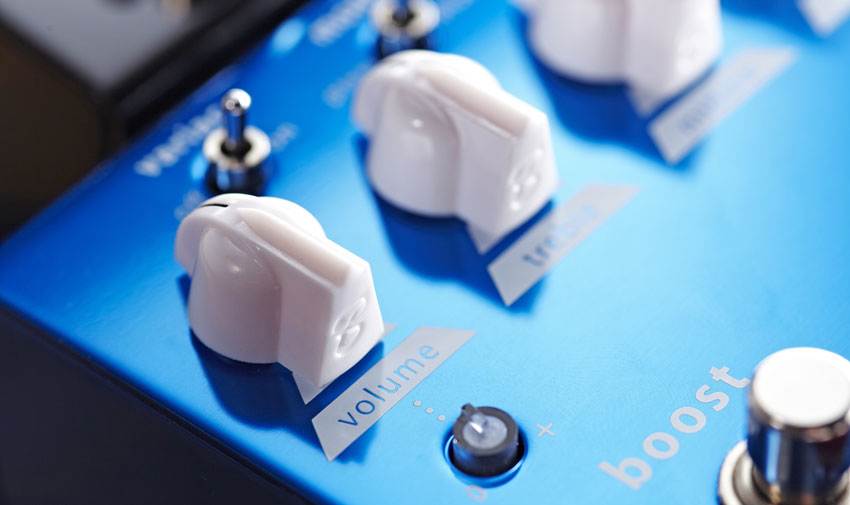MusicRadar Verdict
An amazing pedal from one of the greatest amp designers in the world - not to be missed!
Pros
- +
Bogner build quality. Superlative tone. Very versatile.
Cons
- -
Expensive - unless you compare it with a Bogner amp.
MusicRadar's got your back

Bogner Ecstasy Blue pedal review

Controls
The designer and name-sake of Bogner amps turns his hand to solid-state pedal design and unveils the a new distortion stompbox, the Ecstasy Blue pedal.
Smartly presented in high-quality custom packaging, the Ecstasy Blue uses a tough two-piece aluminium clamshell box fastened by four machine screws. Ultra-sharp white screen-printed logos and lettering top a lacquer-coated special metallic paint finish. Custom miniature chickenhead knobs embossed with the 'B' logo sit alongside LED-lit preset pots and heavy-duty footswitches, creating an air of exclusivity and class.
Inside, the electronics are contained on two high-quality printed circuit boards with gold-plated tracks. There's a mix of quality surface-mount and miniature components, with large portions of the circuits potted in epoxy to prevent competitors from reverse-engineering them. There's also a true bypass on/off switch and a second switch operating a boost.
"The Ecstasy Blue covers the lower-gain classic rock and vintage end of the overdrive spectrum"
In addition to input and output, there's a third jack for remote switching of both functions and an external mains connector for a regular nine-volt DC supply. The PP3 battery sits behind a small aluminium flap, fastened by a large-slotted machine screw - simple and practically unbreakable.
The Ecstasy Blue is based on a channel of Bogner's long-running Ecstasy head, first introduced in 1992. Since then, it's been through several revisions, and the pedal has features that mimic the gain and tone network changes.
The Ecstasy Blue covers the lower-gain classic rock and vintage end of the overdrive spectrum, but with enough in reserve to scream when needed. There are rotary controls for gain, bass, mid, treble and volume, with two presets for gain and volume that operate in the boost mode. Above the rotaries are four mini-toggle switches: Variac, which adds a dynamic compression effect; a mode switch with two gain options called Plexi and Blue; a three-way Pre-EQ switch that offers two types of bright emphasis plus a centre neutral option; and a three-way switch called Structure, which changes the pedal's gain and overall tonality to match the Ecstasy 100, 101 and 20th Anniversary versions.
Overall, it's easily up to the standard we've come to expect from Reinhold's Hollywood workshop: it's robust, built with exceptional attention to detail, and looks good, too.
Want all the hottest music and gear news, reviews, deals, features and more, direct to your inbox? Sign up here.
Sounds
"From Hendrix to Gilmour to SRV, the Blue excels at providing those squashy, compressed, ever-so- slightly overdriven tones"
We tried the Bogner out with a variety of guitars, including a PRS CE with HFS humbuckers, a Les Paul Standard and our Seymour Duncan APS-1- powered Strat. We used several amps, too, from high-end boutique products to gnarly pawn shop rejects. It won't work sonic miracles with less than half-decent amplification - but with a good, Fender-style clean channel driving a 2x12 cab with Vintage 30s, the results were superb.
The Ecstasy Blue favours single coils. The gain settings range from a transparent clean boost to a respectable crunch tone that would serve many players as a great lead sound. Moderate gain settings in 'Plexi' mode provided excellent nearly clean sounds: from Hendrix to Gilmour to SRV, the Blue excels at providing those squashy, compressed, ever-so- slightly overdriven tones.
The four switches and smooth tone controls make it easy to dial in practically any guitar. We tended towards Plexi mode with the Variac off, the B1 EQ setting and the 101 setting on the structure switch. Flipping the Mode switch to Blue adds just the right amount of drive and gain to keep most classic- rock fans happy. This setting works just as well with single coils or the humbuckers on our Les Paul Standard, too.